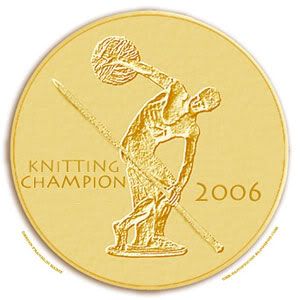*LCK and I were at 3-day Natural Dying and Spinning Intensive class at Deep Color Studio. The class started on Friday night plus six hours on Saturday and six on Sunday. There were a lot of interesting women in our class: college teachers, artists, a beekeeper, a woman who studied textiles in Northern India and a former baker at
Scharffenberger (we had potluck lunches and she brought wonderful home baked desserts).
You know, I've never even tried dying with Kool-Aid so I'm not sure why I'd jump into dying with natural dyes but I can say it's a LOT of work. Hearing all the ingredients we were to use made me feel like I was in Potions class at Hogwarts.
We started out on Friday evening preparing our fiber strips by mordanting them and leaving them over night. On Saturday we focused on mixing dye stocks using madder, fustic, and logwood grey extracts and grinding cochineal (dried bugs!) We dipped 3 strips into canning jars filled with water mixed with our color stocks. The 4th strip we painted using multiple colors, wrapped it in cellophane and also placed it in a canning jar and left them overnight sitting in a huge canning pot where our teacher steamed them after we went home.
The next day we came in, washed and rinsed out our fiber strips, and hung them out to dry:
 LCK photographing the drying strips on the left. The woman on the right is washing her fiber strips.
LCK photographing the drying strips on the left. The woman on the right is washing her fiber strips.
 It was a lot of fun rinsing the fiber to see what happened after leaving it overnight.
It was a lot of fun rinsing the fiber to see what happened after leaving it overnight.
 The deep red strips are from the cochineal dye. The deep orange strip fifth from the left is LCK's dyed in a mixture of madder, cochineal & fustic and next to that is a strip dyed in madder and next to that is one dyed in fustic (I think). The multi colored strip in the middle is my effort at dying using multiple dyes.
The deep red strips are from the cochineal dye. The deep orange strip fifth from the left is LCK's dyed in a mixture of madder, cochineal & fustic and next to that is a strip dyed in madder and next to that is one dyed in fustic (I think). The multi colored strip in the middle is my effort at dying using multiple dyes.
After we finished hanging out strips we prepared the stock for Indigo dying. Because we used lye, we had to be careful with our mixing and measuring and protective glove using.
For successful dying we had to be careful with our dipping so as not to introduce oxygen into the dye bath. It was very cool watching a slimy green strip turn blue as it was pulled from the dye pot and hit the air. The strip on the left is my fustic strip overdyed with indigo.

 In between preparing dyes, prepping fiber, dying fiber and sharing our potluck meals, we spun natural dyed BFL on our drop spindles. From this 'energized' yarn, we immediately started knitting socks straight off the spindle. I really wasn't pleased with how my sock was knitting up (destined to become a cat toy) but I'd like to give it another go to see if I can actually knit a pair of socks from hand spun yarn.
In between preparing dyes, prepping fiber, dying fiber and sharing our potluck meals, we spun natural dyed BFL on our drop spindles. From this 'energized' yarn, we immediately started knitting socks straight off the spindle. I really wasn't pleased with how my sock was knitting up (destined to become a cat toy) but I'd like to give it another go to see if I can actually knit a pair of socks from hand spun yarn.
At the end of the day, I took home several pieces of dyed roving. When LCK updates her blog, I'm sure she'd love to show you HER dyed pieces but some forgetful IDIOT (me) accidentally left her dyed pieces behind at the Studio.
Drying in my back yard:
 Natural dyed fiber is much more subdued than commercial dyed fibers but they're quite soft and lovely.
Natural dyed fiber is much more subdued than commercial dyed fibers but they're quite soft and lovely.
My indigo strips are still drying but here's my very first wheel spun yarn dyed in Indigo:

It was a fun weekend but all that work has left me quite nackerd.

We had a tiring day too.


 It's got some of that cool 70's vibe:
It's got some of that cool 70's vibe: And the blue from that famous hat she tosses in the air:
And the blue from that famous hat she tosses in the air:
 Thank you Jen!!
Thank you Jen!!















































